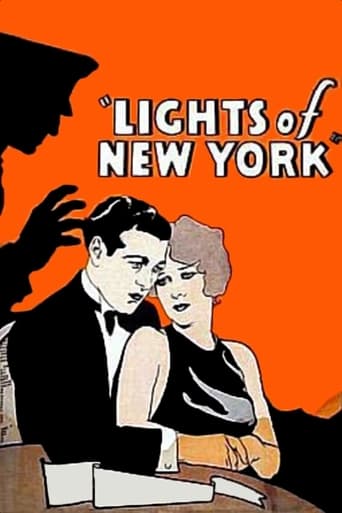gridoon2018
This movie has an important place in the history of cinema (the first all-talkie, although it still carries over a trademark of the silent era: the title cards), but when you get past the novelty value it doesn't really have much artistic value. And even though it runs under an hour, it moves like molasses. But it's still watchable. Some of the actors were clearly not destined for a long career in the talkies (Eugene Palette is the only one you might recognize, especially if you are a Philo Vance fan), but actually Helene Costello and Wheeler Oakman are not bad at all - Oakman even manages a wry delivery with some of his lines, like "cops are my best friends!". **1/2 out of 4.,
Diosprometheus
This is an important historical film since it was the the first all-talking feature film. The film was made for a mere 23,000 dollars.It grossed over a million dollars upon its release. This film all so helped define the gangster melodramas that were to become the bread and butter of the Warner's studio in the 1930's. The popularity of this film ended the silent era more so than its more famous part-talkie predecessor, the Jazz Singer. The film deserves its place in history and not as a mere footnote. The only actor who might be remember today that is in it was Eugene Palette.
drednm
LIGHTS OF NEW YORK was the first "all-taking" feature film, coming in at a brisk 57 minutes and directed by Bryan Foy (of the famous vaudeville family).The story has two dopey barbers (Cullen Landis, Eugene Palette) yearning for a chance at "big city life" and getting involved with gangsters and bootleg booze. One of the guys gets framed for the murder of a cop but is saved at the last minute by a gun moll (Gladys Brockwell).Much of the story takes place in a night club called The Night Hawk, which is run by a crook named Hawk (Wheeler Oakman) who has his eye on a pretty chorine (Helene Costello) who is the girl friend of Landis. Costello gets to do a brief dance, and we hear Harry Downing (made up to resemble Ted Lewis) sing "At Dawning) in his best Al Jolson style.The acting ranges from good (Palette and Brockwell) to awful (Oakman). A couple of the actors muff their lines but then keep right on with the scene. As noted elsewhere this was intended to be a short 2-reeler and was made on a shoestring budget. Yet the sound quality is surprisingly good, the voices all register clearly, and there is a neat cinematic touch in the silhouette death.The film was a box-office smash even though it was shown as a silent film where theaters were not wired for the new sound technology. No one expected this little film to gross an amazing $1.3 million. It briefly made stars of Costello and Landis and certainly launched Palette on his long career as a star character actor.Co-stars include Mary Carr as the mother, Robert Elliott as the detective, Eddie Kane as the street cop, and Tom Dugan as a thug.
jbacks3-1
Okay so I gave this a 6 but to be fair you can't grade Lights of New York in any ordinary sense. The camera's immobile, the acting's on par with lumber and the script's below second-rate. I love the dialog--- Wheeler Oakman's "But... they... must not... find... Eddie" and the infamous, "Take.. him... for... A... ride" is stupifyingly awful (further proof of his thespian skills can be seen in his death scene... then he keeps on breathing!). But hey, this was the very first all-talking movie! There's every reason in the world to make allowances for every one of it's shortcomings. I've seen The Jazz Singer released around 8 months earlier and this represented a huge leap over part-talkies. It's hard to be overly critical on the technical aspects when it's apparent that everyone was dealing with new fangled sound and heavily soundproofed cameras--- not to mention sound requiring completely new types of direction. This is a gem that deserves to be seen and judged for what it is, a historical artifact. Eugene Palette is the best actor here (no surprise).



